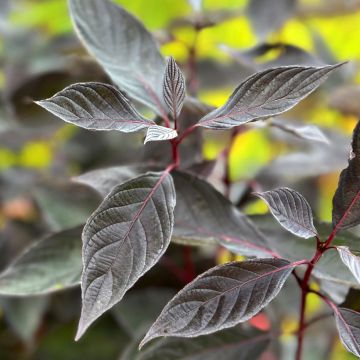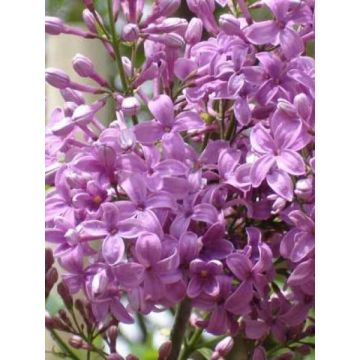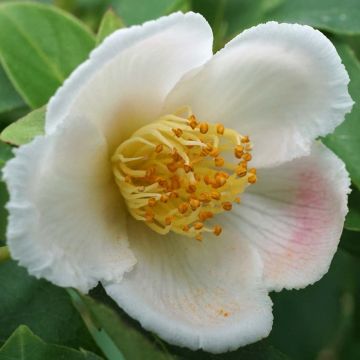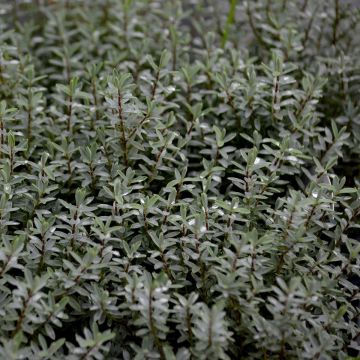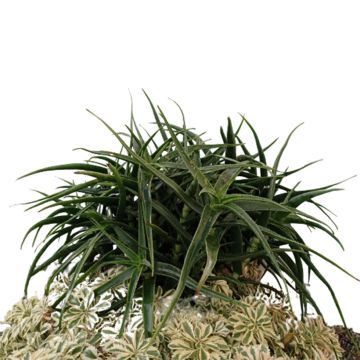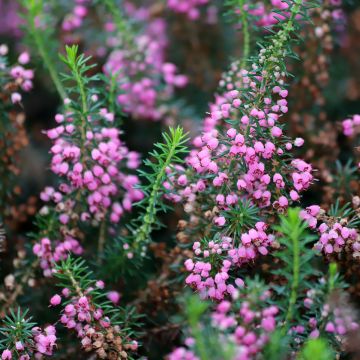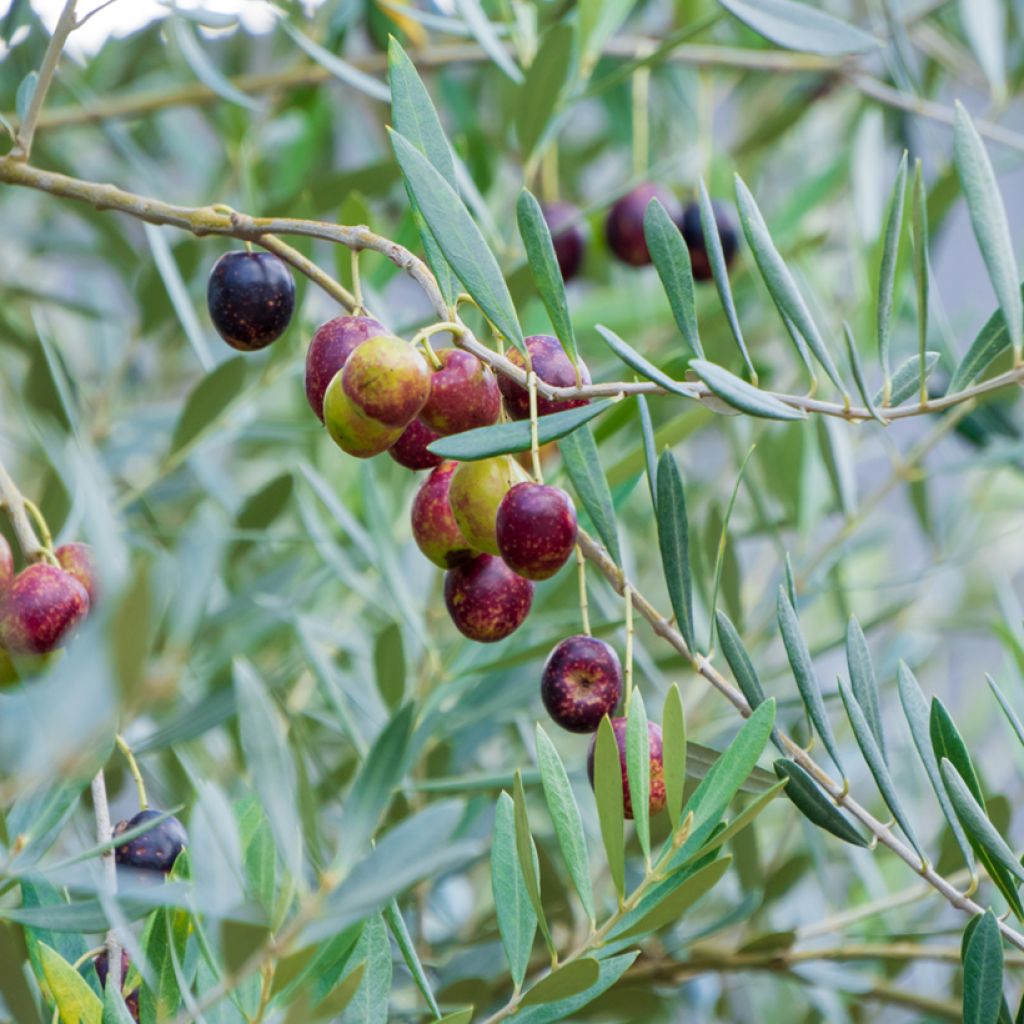

Olea europaea Grossanne - Olive Tree
Olea europaea Grossanne - Olive Tree
Olea europaea Grossanne
European Olive, Olive Tree
Why not try an alternative variety in stock?
View all →This plant carries a 6 months recovery warranty
More information
We guarantee the quality of our plants for a full growing cycle, and will replace at our expense any plant that fails to recover under normal climatic and planting conditions.
Description
The 'Olive tree or Olea europaea 'Grossanne', also known as 'Groussan' is native to the Baux de Provence valley. It is a self-fertile variety that is rather early, appreciated for its hardiness and robustness. The tree produces oval-shaped olives of a good size, which can be used both as table olives and for oil production. The olives can be harvested while still green or when fully ripe and black in November. The 'Grossanne' can withstand short frosts of around -12 to -15°C in well-drained soil. However, like all olive trees, it needs a long warm period between summer and autumn to ripen its fruits.
Do not buy an old subject that has been uprooted without care from its native soil: it will take 5 or 10 years to recover or perish. Instead, plant a young olive tree that is "happy in its pot", water it regularly for the first two or three summers, and you will be surprised at how quickly it grows!
The presence of Olea europaea, simply called Olive, all around the Mediterranean, dates back to ancient times, to the flood, one could say. Both an ornamental tree and a food tree, it is inseparable from the Mediterranean landscape, just like the fig tree, the holm oak, the Provence cypress 'Pyramidalis', the pomegranate, and the grapevine. This emblematic tree has given its name to the botanical family Oleaceae.
Olea europaea 'Grossane' has a characteristic olive tree silhouette, with a rather short trunk that becomes twisted with age, topped by a widely rounded canopy that can be shaped through pruning. Eventually, after many years, it reaches a height of 3 to 4 m with a spread of 2 to 3 m. Its growth is rather slow. Its evergreen foliage consists of opposite, entire, elliptical leaves that are leathery and covered with scale-like hairs, more or less narrow, measuring 3 to 7 cm in length. They cover branches dotted with overlapping scales. Their colour is a mix of green and grey, with the undersides of the leaves being fuzzy and silvery. The brief flowering occurs during one week between March and May, depending on the climate. The white or yellowish flowers are grouped in axillary panicles. The fruits, the olives, are fleshy, oval drupes with hard stones, green and then turning violet to black when ripe. They have an extremely bitter taste and are not edible as they are: they need to undergo processing or a very long ripening period off the tree before consumption. This fruiting occurs after ten years. The bark of this olive tree is grey and smooth when young and cracks with age, while the tree produces shoots at the base of the trunk.
The 'Grossane' olive is larger than those of other varieties which is how it got its name. Its flesh is pulpy and relatively soft. Enthusiasts will say that its oil is mild and fruity, while experts will say that it has a "black fruity" flavour with notes of almond. It is also described, in the case of green fruity, as having "oil without pungency or bitterness, with a light fruity flavour with hints of grapefruit and tomato". "In the case of black fruity, this olive ferments quickly and, when combined with other varieties, it contributes to enhancing the aromatic profile with notes of candied fruits and jam without causing a significant increase in acidity."
The 'Grossane' olive tree is very resistant to drought and it prefers well-drained, even rocky soils. However, it cannot tolerate humid and very cold winters. However, fans of this small tree can still adopt it in a large container, protecting it from severe cold in winter.
The 'Grossane' olive tree naturally finds a place in a Mediterranean garden, orchard, or near a terrace. When planted as a solitary specimen, it adds character to the garden. Avoid planting it in a regularly watered lawn in summer, as it is not suitable. A climbing rose such as 'Alberic Barbier', 'Albertine', 'Felicia', or 'Senator Lafolette' is often planted at the base of an olive tree in the south. Although it may not aid harvesting (in November), they form a charming and elegant duo when the rose is in bloom. Further north, it is best to cultivate it next to oleanders in large containers that can be sheltered in winter.
A very old tree: the Olive tree, named "The King of Kings" in Roquebrune-Cap-Martin, in the Alpes-Maritimes region, has a trunk with a circumference of 20m, encompassing the surrounding rocks; it is estimated to be 1000 to 2000 years old.
Report an error about the product description
Plant habit
Fruit
Flowering
Foliage
Safety measures
Botanical data
Olea
europaea
Grossanne
Oleaceae
European Olive, Olive Tree
Olea europea Groussan
Mediterranean
atteinterespiratoire
Cette plante peut entraîner des symptômes allergiques.
Evitez de la planter si vous ou vos proches souffrez de rhinite saisonnière ("rhume des foins").
Davantage d'informations sur https://plantes-risque.info
Other Shrubs A to Z
View all →Planting and care
The 'Grossanne' Olive tree is best planted in spring in areas with borderline hardiness, as young plants are particularly sensitive to cold, while well-established specimens that are a few years old can withstand short frosts of around -12 to -15°C. If you plant the olive tree in open ground, dig a hole around the tree. Do not plant it in the middle of the lawn, as it would suffer from regular watering, which would cause asphyxiation and root rot. The olive tree is content with ordinary soil, even limestone and stony soil, but above all it needs to be permeable and well-drained. It can tolerate summer drought perfectly, sometimes at the expense of the harvest. It also requires a sunny location sheltered from cold winds, especially outside the area where it is traditionally grown.
In an orchard, leave a spacing of 2.50m between each tree.
For an olive tree grown in a pot, place a draining layer of soil, sand, and small stones at the bottom. Repot every 2 or 3 years.
Use a 2.50m tall stake to ensure an upright habit for the tree as it grows. Adjust the height of the stake according to the size of your olive tree in the case of pot cultivation.
Diseases and pests: there are many, but rarely fatal.
The Olive fly, mainly troublesome for fruit production. Thrips, black scale, often accompanied by sooty mould. Bark beetles, moths, spirals.
With one exception, a fungal disease called root rot that attacks the roots and then spreads throughout the branches, olive tree diseases are not lethal and can be easily treated or disappear on their own.
Planting period
Intended location
Care
Planting & care advice
This item has not been reviewed yet - be the first to leave a review about it.
Similar products
Haven't found what you were looking for?
Hardiness is the lowest winter temperature a plant can endure without suffering serious damage or even dying. However, hardiness is affected by location (a sheltered area, such as a patio), protection (winter cover) and soil type (hardiness is improved by well-drained soil).

Photo Sharing Terms & Conditions
In order to encourage gardeners to interact and share their experiences, Promesse de fleurs offers various media enabling content to be uploaded onto its Site - in particular via the ‘Photo sharing’ module.
The User agrees to refrain from:
- Posting any content that is illegal, prejudicial, insulting, racist, inciteful to hatred, revisionist, contrary to public decency, that infringes on privacy or on the privacy rights of third parties, in particular the publicity rights of persons and goods, intellectual property rights, or the right to privacy.
- Submitting content on behalf of a third party;
- Impersonate the identity of a third party and/or publish any personal information about a third party;
In general, the User undertakes to refrain from any unethical behaviour.
All Content (in particular text, comments, files, images, photos, videos, creative works, etc.), which may be subject to property or intellectual property rights, image or other private rights, shall remain the property of the User, subject to the limited rights granted by the terms of the licence granted by Promesse de fleurs as stated below. Users are at liberty to publish or not to publish such Content on the Site, notably via the ‘Photo Sharing’ facility, and accept that this Content shall be made public and freely accessible, notably on the Internet.
Users further acknowledge, undertake to have ,and guarantee that they hold all necessary rights and permissions to publish such material on the Site, in particular with regard to the legislation in force pertaining to any privacy, property, intellectual property, image, or contractual rights, or rights of any other nature. By publishing such Content on the Site, Users acknowledge accepting full liability as publishers of the Content within the meaning of the law, and grant Promesse de fleurs, free of charge, an inclusive, worldwide licence for the said Content for the entire duration of its publication, including all reproduction, representation, up/downloading, displaying, performing, transmission, and storage rights.
Users also grant permission for their name to be linked to the Content and accept that this link may not always be made available.
By engaging in posting material, Users consent to their Content becoming automatically accessible on the Internet, in particular on other sites and/or blogs and/or web pages of the Promesse de fleurs site, including in particular social pages and the Promesse de fleurs catalogue.
Users may secure the removal of entrusted content free of charge by issuing a simple request via our contact form.
The flowering period indicated on our website applies to countries and regions located in USDA zone 8 (France, the United Kingdom, Ireland, the Netherlands, etc.)
It will vary according to where you live:
- In zones 9 to 10 (Italy, Spain, Greece, etc.), flowering will occur about 2 to 4 weeks earlier.
- In zones 6 to 7 (Germany, Poland, Slovenia, and lower mountainous regions), flowering will be delayed by 2 to 3 weeks.
- In zone 5 (Central Europe, Scandinavia), blooming will be delayed by 3 to 5 weeks.
In temperate climates, pruning of spring-flowering shrubs (forsythia, spireas, etc.) should be done just after flowering.
Pruning of summer-flowering shrubs (Indian Lilac, Perovskia, etc.) can be done in winter or spring.
In cold regions as well as with frost-sensitive plants, avoid pruning too early when severe frosts may still occur.
The planting period indicated on our website applies to countries and regions located in USDA zone 8 (France, United Kingdom, Ireland, Netherlands).
It will vary according to where you live:
- In Mediterranean zones (Marseille, Madrid, Milan, etc.), autumn and winter are the best planting periods.
- In continental zones (Strasbourg, Munich, Vienna, etc.), delay planting by 2 to 3 weeks in spring and bring it forward by 2 to 4 weeks in autumn.
- In mountainous regions (the Alps, Pyrenees, Carpathians, etc.), it is best to plant in late spring (May-June) or late summer (August-September).
The harvesting period indicated on our website applies to countries and regions in USDA zone 8 (France, England, Ireland, the Netherlands).
In colder areas (Scandinavia, Poland, Austria...) fruit and vegetable harvests are likely to be delayed by 3-4 weeks.
In warmer areas (Italy, Spain, Greece, etc.), harvesting will probably take place earlier, depending on weather conditions.
The sowing periods indicated on our website apply to countries and regions within USDA Zone 8 (France, UK, Ireland, Netherlands).
In colder areas (Scandinavia, Poland, Austria...), delay any outdoor sowing by 3-4 weeks, or sow under glass.
In warmer climes (Italy, Spain, Greece, etc.), bring outdoor sowing forward by a few weeks.









































